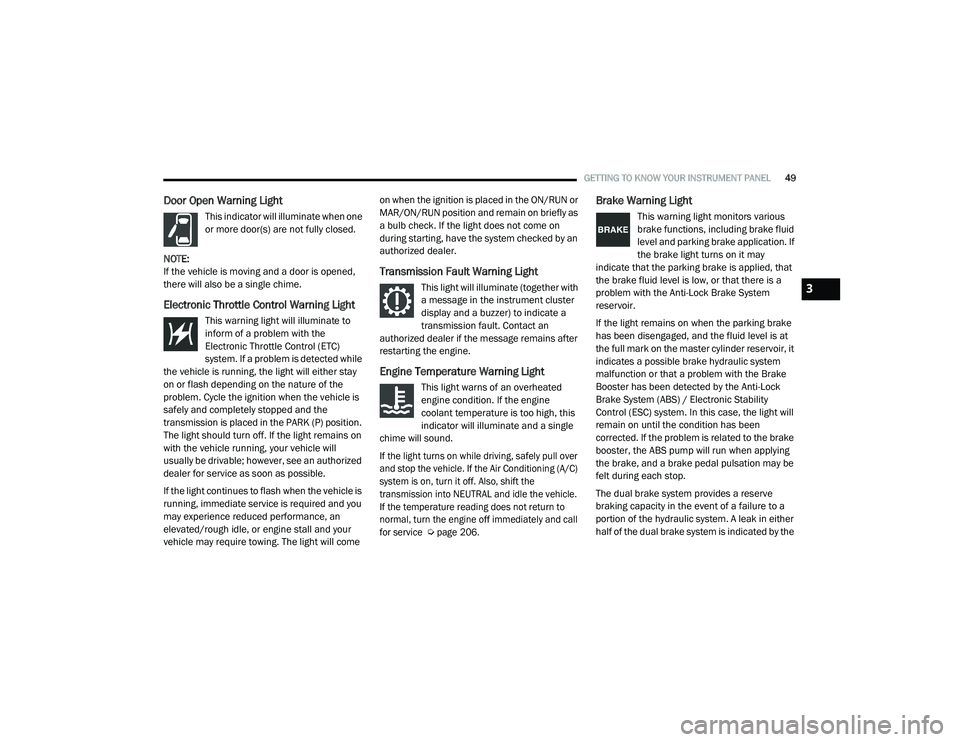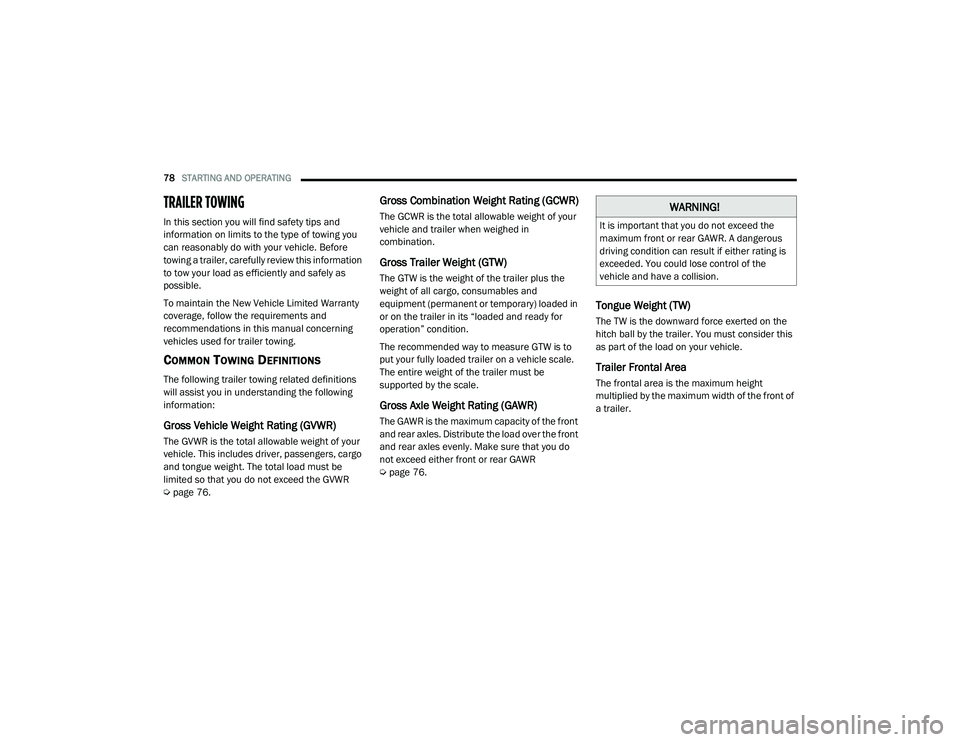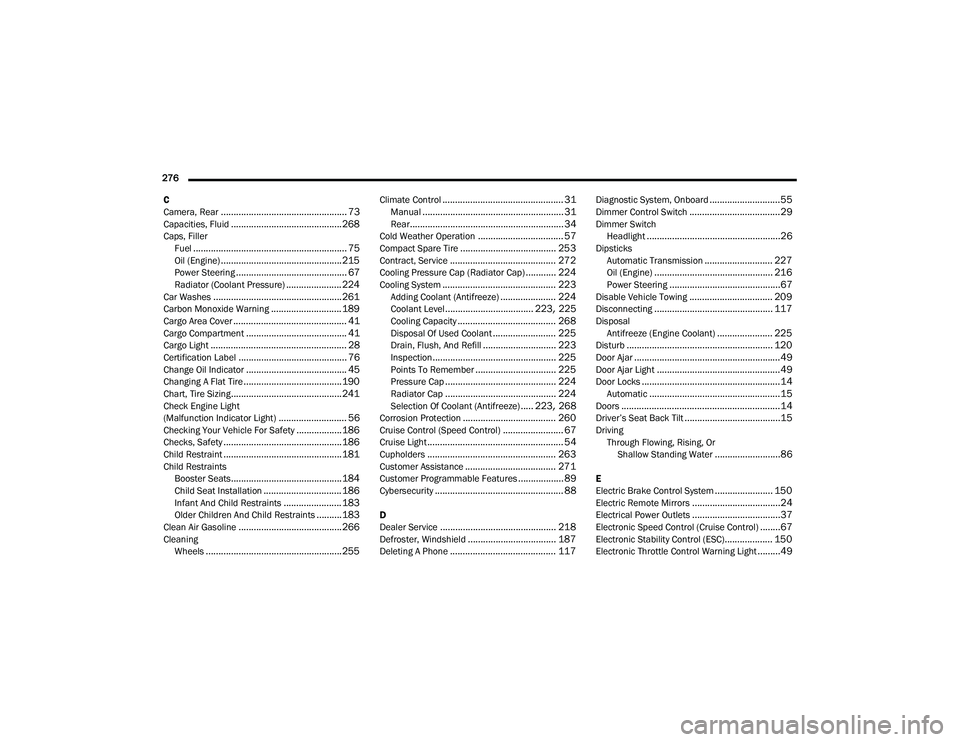towing capacity RAM PROMASTER 2021 Owners Manual
[x] Cancel search | Manufacturer: RAM, Model Year: 2021, Model line: PROMASTER, Model: RAM PROMASTER 2021Pages: 288, PDF Size: 15.22 MB
Page 51 of 288

GETTING TO KNOW YOUR INSTRUMENT PANEL49
Door Open Warning Light
This indicator will illuminate when one
or more door(s) are not fully closed.
NOTE:
If the vehicle is moving and a door is opened,
there will also be a single chime.
Electronic Throttle Control Warning Light
This warning light will illuminate to
inform of a problem with the
Electronic Throttle Control (ETC)
system. If a problem is detected while
the vehicle is running, the light will either stay
on or flash depending on the nature of the
problem. Cycle the ignition when the vehicle is
safely and completely stopped and the
transmission is placed in the PARK (P) position.
The light should turn off. If the light remains on
with the vehicle running, your vehicle will
usually be drivable; however, see an authorized
dealer for service as soon as possible.
If the light continues to flash when the vehicle is
running, immediate service is required and you
may experience reduced performance, an
elevated/rough idle, or engine stall and your
vehicle may require towing. The light will come on when the ignition is placed in the ON/RUN or
MAR/ON/RUN position and remain on briefly as
a bulb check. If the light does not come on
during starting, have the system checked by an
authorized dealer.
Transmission Fault Warning Light
This light will illuminate (together with
a message in the instrument cluster
display and a buzzer) to indicate a
transmission fault. Contact an
authorized dealer if the message remains after
restarting the engine.
Engine Temperature Warning Light
This light warns of an overheated
engine condition. If the engine
coolant temperature is too high, this
indicator will illuminate and a single
chime will sound.
If the light turns on while driving, safely pull over
and stop the vehicle. If the Air Conditioning (A/C)
system is on, turn it off. Also, shift the
transmission into NEUTRAL and idle the vehicle.
If the temperature reading does not return to
normal, turn the engine off immediately and call
for service
Ú
page 206.
Brake Warning Light
This warning light monitors various
brake functions, including brake fluid
level and parking brake application. If
the brake light turns on it may
indicate that the parking brake is applied, that
the brake fluid level is low, or that there is a
problem with the Anti-Lock Brake System
reservoir.
If the light remains on when the parking brake
has been disengaged, and the fluid level is at
the full mark on the master cylinder reservoir, it
indicates a possible brake hydraulic system
malfunction or that a problem with the Brake
Booster has been detected by the Anti-Lock
Brake System (ABS) / Electronic Stability
Control (ESC) system. In this case, the light will
remain on until the condition has been
corrected. If the problem is related to the brake
booster, the ABS pump will run when applying
the brake, and a brake pedal pulsation may be
felt during each stop.
The dual brake system provides a reserve
braking capacity in the event of a failure to a
portion of the hydraulic system. A leak in either
half of the dual brake system is indicated by the
3
21_VF_OM_EN_USC_t.book Page 49
Page 80 of 288

78STARTING AND OPERATING
TRAILER TOWING
In this section you will find safety tips and
information on limits to the type of towing you
can reasonably do with your vehicle. Before
towing a trailer, carefully review this information
to tow your load as efficiently and safely as
possible.
To maintain the New Vehicle Limited Warranty
coverage, follow the requirements and
recommendations in this manual concerning
vehicles used for trailer towing.
COMMON TOWING DEFINITIONS
The following trailer towing related definitions
will assist you in understanding the following
information:
Gross Vehicle Weight Rating (GVWR)
The GVWR is the total allowable weight of your
vehicle. This includes driver, passengers, cargo
and tongue weight. The total load must be
limited so that you do not exceed the GVWR
Úpage 76.
Gross Combination Weight Rating (GCWR)
The GCWR is the total allowable weight of your
vehicle and trailer when weighed in
combination.
Gross Trailer Weight (GTW)
The GTW is the weight of the trailer plus the
weight of all cargo, consumables and
equipment (permanent or temporary) loaded in
or on the trailer in its “loaded and ready for
operation” condition.
The recommended way to measure GTW is to
put your fully loaded trailer on a vehicle scale.
The entire weight of the trailer must be
supported by the scale.
Gross Axle Weight Rating (GAWR)
The GAWR is the maximum capacity of the front
and rear axles. Distribute the load over the front
and rear axles evenly. Make sure that you do
not exceed either front or rear GAWR
Úpage 76.
Tongue Weight (TW)
The TW is the downward force exerted on the
hitch ball by the trailer. You must consider this
as part of the load on your vehicle.
Trailer Frontal Area
The frontal area is the maximum height
multiplied by the maximum width of the front of
a trailer.
WARNING!
It is important that you do not exceed the
maximum front or rear GAWR. A dangerous
driving condition can result if either rating is
exceeded. You could lose control of the
vehicle and have a collision.
21_VF_OM_EN_USC_t.book Page 78
Page 84 of 288

82STARTING AND OPERATING
(Continued)
Towing Requirements — Tires
Do not attempt to tow a trailer while using a
compact spare tire.
Do not drive more than 50 mph (80 km/h) when towing while using a full size spare tire.
Proper tire inflation pressures are essential
to the safe and satisfactory operation of your
vehicle.
Check the trailer tires for proper tire inflation
pressures before trailer usage.
Check for signs of tire wear or visible tire
damage before towing a trailer.
Replacing tires with a higher load carrying
capacity will not increase the vehicle's GVWR
and GAWR limits.
For further information Ú page 240.
Towing Requirements — Trailer Brakes
Do not interconnect the hydraulic brake
system or vacuum system of your vehicle
with that of the trailer. This could cause inad -
equate braking and possible personal injury.
WARNING!
Make certain that the load is secured in the
trailer and will not shift during travel. When
trailering cargo that is not fully secured,
dynamic load shifts can occur that may be
difficult for the driver to control. You could
lose control of your vehicle and have a
collision.
When hauling cargo or towing a trailer, do
not overload your vehicle or trailer. Over -
loading can cause a loss of control, poor
performance or damage to brakes, axle,
engine, transmission, steering, suspension,
chassis structure or tires.
Safety chains must always be used
between your vehicle and trailer. Always
connect the chains to the hook retainers of
the vehicle hitch. Cross the chains under
the trailer tongue and allow enough slack
for turning corners.
Vehicles with trailers should not be parked
on a grade. When parking, apply the
parking brake on the tow vehicle. Put the
tow vehicle transmission in PARK. For
four-wheel drive vehicles, make sure the
transfer case is not in NEUTRAL. Always,
block or "chock" the trailer wheels.
GCWR must not be exceeded.
Total weight must be distributed between
the tow vehicle and the trailer such that the
following four ratings are not exceeded :
GVWR
GTW
GAWR
Tongue weight rating for the trailer
hitch utilized.
WARNING! (Continued)
21_VF_OM_EN_USC_t.book Page 82
Page 85 of 288

STARTING AND OPERATING83
An electronically actuated trailer brake
controller is required when towing a trailer
with electronically actuated brakes. When
towing a trailer equipped with a hydraulic
surge actuated brake system, an electronic
brake controller is not required.
Trailer brakes are recommended for trailers
over 1,000 lbs (453 kg) and may be required
for any trailer, for example trailers in excess
of 2,000 lbs (907 kg). Trailer brake require -
ments vary by local law, consult local legal
requirements where the trailer is to be towed
for trailer brake requirements.
Towing Requirements — Trailer Lights And
Wiring
Whenever you pull a trailer, regardless of the
trailer size, stoplights and turn signals on the
trailer are required for motoring safety.
The Trailer Tow Package may include a four- and
seven-pin wiring harness. Use a factory
approved trailer harness and connector.
NOTE:
Do not cut or splice wiring into the vehicle’s
wiring harness.
The electrical connections are all complete to
the vehicle but you must mate the harness to a
trailer connector. Refer to the following
illustrations. NOTE:
Disconnect trailer wiring connector from the
vehicle before launching a boat (or any other
device plugged into vehicle’s electrical
connect) into water.
Be sure to reconnect after clear from water
area.
Four-Pin Connector
WARNING!
Do not connect trailer brakes to your
vehicle's hydraulic brake lines. It can over -
load your brake system and cause it to fail.
You might not have brakes when you need
them and could have an accident.
Towing any trailer will increase your stop -
ping distance. When towing, you should
allow for additional space between your
vehicle and the vehicle in front of you.
Failure to do so could result in an accident.
CAUTION!
If the trailer weighs more than 1,000 lbs
(453 kg) loaded, it should have its own
brakes and they should be of adequate
capacity. Failure to do this could lead to
accelerated brake lining wear, higher brake
pedal effort, and longer stopping distances.
1 — Ground
2 — Tail Lamp
3 — Left Stop/Turn
4 — Right Stop/Turn
4
21_VF_OM_EN_USC_t.book Page 83
Page 248 of 288

246SERVICING AND MAINTENANCE
NOTE:
Under a maximum loaded vehicle condition,
gross axle weight ratings (GAWRs) for the front
and rear axles must not be exceeded.
For further information on GAWRs, vehicle
loading, and trailer towing Úpage 76.
To determine the maximum loading conditions
of your vehicle, locate the statement “The
combined weight of occupants and cargo
should never exceed XXX kg or XXX lbs” on the
Tire and Loading Information placard. The
combined weight of occupants, cargo/luggage
and trailer tongue weight (if applicable) should
never exceed the weight referenced here.
Steps For Determining Correct Load
Limit—
(1) Locate the statement “The combined
weight of occupants and cargo should
never exceed XXX kg or XXX lbs.” on your
vehicle's placard.
(2) Determine the combined weight of
the driver and passengers that will be
riding in your vehicle. (3) Subtract the combined weight of the
driver and passengers from XXX kg or
XXX lbs.
(4) The resulting figure equals the
available amount of cargo and luggage
load capacity. For example, if “XXX”
amount equals 1400 lbs. and there will
be five 150 lb passengers in your
vehicle, the amount of available cargo
and luggage load capacity is 650 lbs.
(1400-750 (5x150) = 650 lbs.)
(5) Determine the combined weight of
luggage and cargo being loaded on the
vehicle. That weight may not safely
exceed the available cargo and luggage
load capacity calculated in Step 4.
(6) If your vehicle will be towing a trailer,
load from your trailer will be transferred
to your vehicle. Consult this manual to
determine how this reduces the
available cargo and luggage load
capacity of your vehicle.
Metric Example For Load Limit
For example, if “XXX” amount equals 635 kg
and there will be five 68 kg passengers in your
vehicle, the amount of available cargo and
luggage load capacity is 295 kg (635-340
(5x68) = 295 kg) as shown in step 4.
NOTE:
If your vehicle will be towing a trailer, load
from your trailer will be transferred to your
vehicle. The following table shows examples
on how to calculate total load, cargo/
luggage, and towing capacities of your
vehicle with varying seating configurations
and number and size of occupants. This table
is for illustration purposes only and may not
be accurate for the seating and load carry
capacity of your vehicle.
For the following example, the combined
weight of occupants and cargo should never
exceed 865 lbs (392 kg).
21_VF_OM_EN_USC_t.book Page 246
Page 278 of 288

276 C
Camera, Rear
.................................................. 73Capacities, Fluid............................................ 268Caps, Filler Fuel............................................................. 75Oil (Engine)................................................ 215Power Steering............................................ 67Radiator (Coolant Pressure)...................... 224Car Washes................................................... 261Carbon Monoxide Warning............................ 189Cargo Area Cover............................................. 41Cargo Compartment........................................ 41Cargo Light...................................................... 28Certification Label........................................... 76Change Oil Indicator........................................ 45Changing A Flat Tire....................................... 190Chart, Tire Sizing............................................ 241Check Engine Light
(Malfunction Indicator Light)........................... 56Checking Your Vehicle For Safety.................. 186Checks, Safety............................................... 186Child Restraint............................................... 181Child RestraintsBooster Seats............................................ 184Child Seat Installation............................... 186Infant And Child Restraints....................... 183Older Children And Child Restraints..........183Clean Air Gasoline......................................... 266CleaningWheels...................................................... 255
Climate Control................................................ 31Manual........................................................ 31Rear............................................................. 34Cold Weather Operation.................................. 57Compact Spare Tire...................................... 253Contract, Service.......................................... 272Cooling Pressure Cap (Radiator Cap)............ 224Cooling System............................................. 223Adding Coolant (Antifreeze)...................... 224Coolant Level................................... 223, 225Cooling Capacity....................................... 268Disposal Of Used Coolant......................... 225Drain, Flush, And Refill............................. 223Inspection................................................. 225Points To Remember................................ 225Pressure Cap............................................ 224Radiator Cap............................................ 224Selection Of Coolant (Antifreeze)..... 223, 268Corrosion Protection..................................... 260Cruise Control (Speed Control)........................ 67Cruise Light...................................................... 54Cupholders................................................... 263Customer Assistance.................................... 271Customer Programmable Features.................. 89Cybersecurity................................................... 88
D
Dealer Service.............................................. 218Defroster, Windshield................................... 187Deleting A Phone.......................................... 117
Diagnostic System, Onboard............................55Dimmer Control Switch....................................29Dimmer SwitchHeadlight.....................................................26DipsticksAutomatic Transmission........................... 227Oil (Engine)............................................... 216Power Steering............................................67Disable Vehicle Towing................................. 209Disconnecting............................................... 117DisposalAntifreeze (Engine Coolant)...................... 225Disturb.......................................................... 120Door Ajar..........................................................49Door Ajar Light.................................................49Door Locks.......................................................14Automatic....................................................15Doors...............................................................14Driver’s Seat Back Tilt......................................15DrivingThrough Flowing, Rising, Or Shallow Standing Water
..........................86
E
Electric Brake Control System....................... 150Electric Remote Mirrors...................................24Electrical Power Outlets...................................37Electronic Speed Control (Cruise Control)........67Electronic Stability Control (ESC)................... 150Electronic Throttle Control Warning Light.........49
21_VF_OM_EN_USC_t.book Page 276
Page 283 of 288

281
Storing Your Vehicle
...................................... 260Supplemental Restraint System – Air Bag..... 174Sway Control, Trailer...................................... 154Synthetic Engine Oil....................................... 218
T
Telescoping Steering Column.......................... 15Tire And Loading Information Placard........... 245Tire Markings................................................. 240Tire Safety Information.................................. 240Tire Service Kit.................. 197, 198, 200, 202Tires................................... 188, 248, 253, 259Aging (Life Of Tires)................................... 251Air Pressure............................................... 248Chains....................................................... 257Changing................................................... 190Compact Spare......................................... 253General Information........................ 248, 253High Speed................................................ 249Inflation Pressure...................................... 249Jacking...................................................... 190Life Of Tires............................................... 251Load Capacity............................................ 245Pressure Monitoring System (TPMS)............................... 51, 161Quality Grading.......................................... 259Radial........................................................ 250Replacement............................................. 251Rotation.................................................... 258
Safety.............................................. 240, 248Sizes......................................................... 241Snow Tires................................................ 253Spare Tires...................................... 253, 255Spinning................................................... 250Trailer Towing.............................................. 82Tread Wear Indicators.............................. 251Wheel Nut Torque..................................... 264To Open Hood.................................................. 40Tongue Weight/Trailer Weight......................... 81Torque Converter Clutch.................................. 66Towing....................................................78, 209Disabled Vehicle....................................... 209Guide........................................................... 81Recreational................................................ 85Weight......................................................... 81Towing Behind A Motorhome........................... 85Traction............................................................ 86Traction Control............................................ 154Trailer Sway Control (TSC)............................. 154Trailer Towing.................................................. 78Hitches........................................................ 80Minimum Requirements.............................. 81Tips.............................................................. 84Trailer And Tongue Weight........................... 81Wiring.......................................................... 83Trailer Towing Guide........................................ 81Trailer Weight................................................... 81
TransmissionAutomatic.......................................... 60, 226Fluid.......................................................... 270Maintenance............................................ 226Transporting Pets.......................................... 187Tread Wear Indicators................................... 251Turn Signals.....................................................54
U
UconnectPhone Call Features
................................. 118Things You Should Know About YourUconnect Phone................................... 121Uconnect Phone..........................113, 114, 116Answer Or Ignore An Incoming Call — Call Currently In Progress..................... 120Answer Or Ignore An Incoming Call —No Call Currently In Progress................ 119Bluetooth Communication Link................ 124Call Continuation...................................... 121Call Controls............................................. 119Call Termination....................................... 121Cancel Command..................................... 114Connecting To A Particular Mobile Phone Or Audio Device After Pairing................ 116Help Command......................................... 114Join Calls.................................................. 12111
21_VF_OM_EN_USC_t.book Page 281